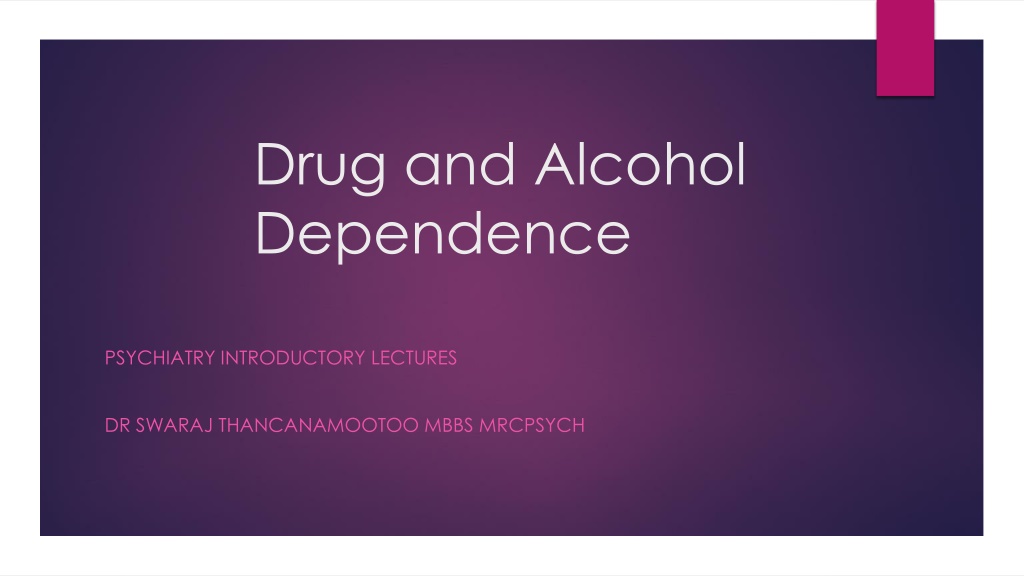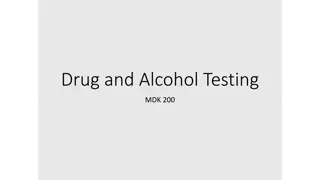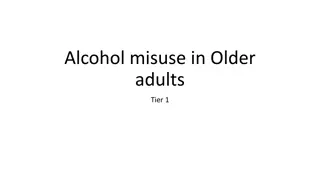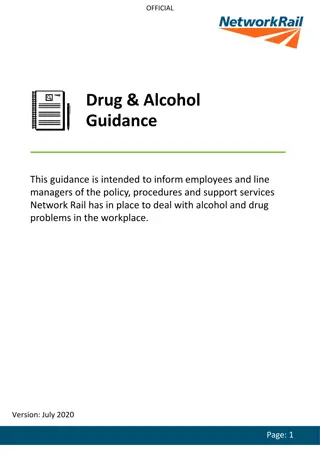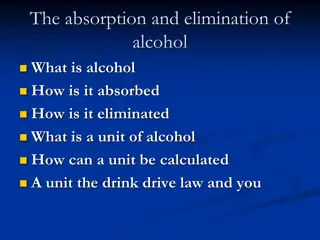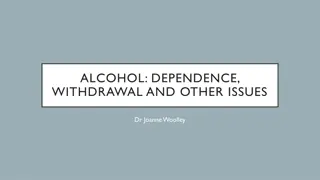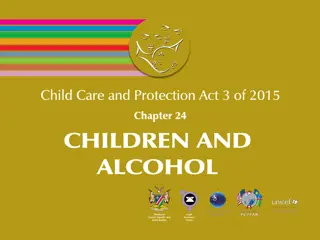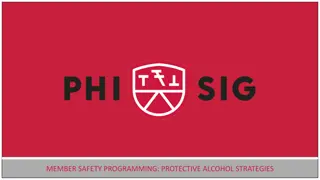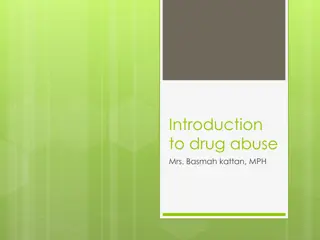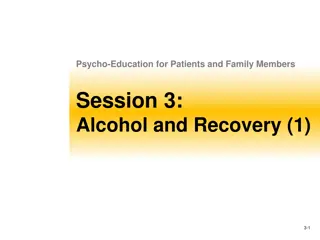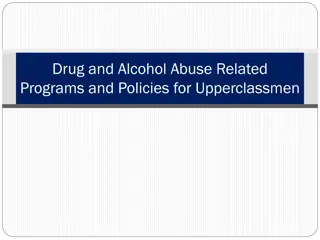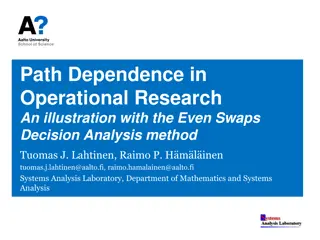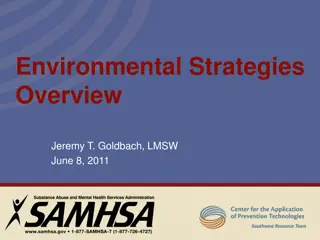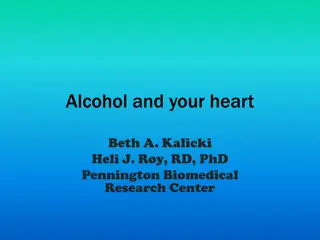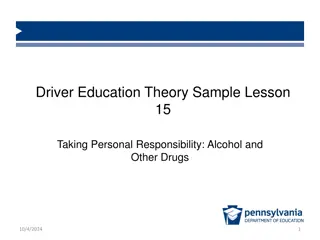Understanding Drug and Alcohol Dependence in Psychiatry: Introductory Lectures
Alcohol consumption can lead to relaxation and pleasure for many, but it can also result in hazardous or harmful use, causing physical or mental damage. Dependence may develop with repeated substance use, leading to withdrawal symptoms. Alcohol abuse is a significant public health issue, with millions in England exceeding recommended limits, resulting in substantial societal and economic costs.
Download Presentation

Please find below an Image/Link to download the presentation.
The content on the website is provided AS IS for your information and personal use only. It may not be sold, licensed, or shared on other websites without obtaining consent from the author. Download presentation by click this link. If you encounter any issues during the download, it is possible that the publisher has removed the file from their server.
E N D
Presentation Transcript
Drug and Alcohol Dependence PSYCHIATRY INTRODUCTORY LECTURES DR SWARAJ THANCANAMOOTOO MBBS MRCPSYCH
Contents General Concepts Assessment/Clinical Features Alcohol Assessment/Clinical Features Substance Misuse Treatment Strategies
General Concepts Use Drinking alcohol is widely associated with relaxation and pleasure, and some people drink without experiencing harmful effects Hazardous A pattern of substance use that increases the risk of harmful consequences to the user Harmful A pattern of psychoactive substance use that is causing damage to health. The damage may be physical (e.g. hepatitis) or mental (e.g. depressive episodes secondary to heavy alcohol intake). Harmful use commonly, but not invariably, has adverse social consequences, although social consequences in themselves, are not sufficient to justify a diagnosis of harmful use
Concepts Contd Dependence A cluster of behavioural, cognitive, and physiological phenomena that develop after repeated substance use and that typically include a strong desire to take the drug, difficulties in controlling its use, persisting in its use despite harmful consequences, a higher priority given to drug use than to other activities and obligations, increased tolerance and sometimes a physical withdrawal state Withdrawal state Clear evidence of recent cessation or reduction of substance use after repeated, and usually prolonged and/or high-dose use of that substance Symptoms and signs compatible with the known features of a withdrawal state from the particular substance or substances
Alcohol Safe units Epidemiology Up to 14 units a week > 9 million people in England drink more than the recommended 14-35 - hazardous use 10% of the UK burden of disease and death, making it one of the 3 biggest lifestyle factors for disease after smoking and obesity More than 35 harmful use Note recent change in guidelines (used to be separate guidelines for males and females) Costs 21bn per year in healthcare, crime and lost productivity costs
Alcohol recap Following ingestion, alcohol is rapidly absorbed in the gut and enters the bloodstream with a peak in blood alcohol concentration after 30-60 minutes It readily crosses the blood brain barrier to enter the brain where it causes subjective or psychoactive and behavioural effects, and, following high levels of chronic alcohol intake, it can cause cognitive impairment and brain damage Alcohol is excreted in urine, sweat and breath, but the main method of elimination from the body is by metabolism in the liver where it is converted to acetaldehyde and acetate, which are excreted primarily in urine
Alcohol effects Brain In a single drinking episode, increasing levels of alcohol lead initially to stimulation (experienced as pleasure), excitement and talkativeness At increasing concentrations alcohol causes sedation leading to sensations of relaxation, then later to slurred speech, unsteadiness, loss of coordination, incontinence, coma and ultimately death through alcohol poisoning, due to the sedation of the vital brain functions on breathing and circulation Main neurotransmitter systems affected by alcohol are GABA (gamma- aminobutyric acid), glutamate and dopamine Intoxication Sober Withdrawal
Screening Opportunistic Clinical presentation, e.g. smelling of alcohol Questionnaires CAGE Do you feel that you have to Cut down on your drinking Do people Annoy you by criticising your drinking Do you feel Guilty about your drinking Do you have to drink first thing in the morning (Eye opener)to steady your nerves AUDIT see next slide Bloods LFT s, GGT, FBC, B12, Folate Blood alcohol breath test can be used to determine if a person has been drinking alcohol recently but does not diagnose alcoholism
Alcohol Assessment Take a HISTORY Current use Longitudinal history Dependence features Impact of drinking Other drugs Previous treatment/abstinence Full history Past psychiatric history, past medical history, medication history, social history, personal history, family history, forensic history Screen for affective and psychotic symptoms
Alcohol Assessment Current Use Do you drink alcohol at all? What do you usually drink? How often do you have a drink? How many drinking do you have on a typical day of drinking Describe a typical day for me, Could you describe a pattern? What sort of effect does alcohol have on you?
Alcohol Assessment Longitudinal history A longitudinal history of how the patients drinking behaviour has developed This should include: Onset and duration Predisposing factors Variation of drinking over time Variations in types of alcohol used Periods of abstinence Any interventions to control or stop drinking
Alcohol Assessment Longitudinal history When did it all start? What was the first drink? With whom did you have the first drink? Was it out of your own will (or) peer pressure? How did you progress to the current level? Started drinking occasionally (social drink) Regular weekend drinking How much would you drink at the weekend What did you used to drink in the past? And what do you drink now?
Edward and Gross Dependence 1976 Narrowing of the drinking repertoire Salience of drink seeking behaviour Increased tolerance to alcohol Repeated withdrawal symptoms Relief or avoidance of withdrawal symptoms by further drinking Subjective awareness of compulsion to drink Reinstatement after abstinence
Dependence Tolerance How much can you drink without feeling drunk? Nowadays, do you need more alcohol to get drunk than you needed before? Does a drink have less of an effect on you than before? Withdrawal What happens if you miss your drink? What would happen if you go without a drink for a day or two? If you don t drink for a day, do you experience any withdrawal symptoms such as sweating, shaking, feeling sick, headaches and pounding in your heart Compulsion Do you sometimes crave a drink? Do you have a compulsive urge to drink? Do you find it hard to stop drinking once you start?
Risk Factors Occupation (publican/catering, travelling businessman/woman, doctors) Psychiatric history Family history of alcoholism Premorbid personality
Impact of Drinking Physical health problems Open What do you think are the consequences of your drinking? Have you ever had any health problems due to drinking? Closed Accidents and head injury, memory problems, blackouts, falls, fits Loss of appetite, weight loss Mental health problems Have you ever had severe shaking, heard voices and seen things that were not there after heavy drinking Anxiety, depression Suicidal ideation/behaviour
Impact of Drinking Relationships Has your drinking ever led to problems with your family, friends, work or the police? How has it affected your family life? Have you had any rows or arguments with friends or mates Work Has your drinking had an effect on your job like missing work, being late or absence from work? Financial Have you ever had any financial problems because of alcohol?
Impact of drinking Legal problems Have you actually had an accident or hurt yourself because of drink? Have you ever been convicted of drink driving? Have you every been arrested because of your drinking?
Insight and Motivation Do you think that the problems you experience currently is related in any way to your drinking? What makes you fee that way and could you explain that? Do you feel you have a problems with alcohol? What would you like to do? Have you ever thought of giving it up completely? What do you think will happen if you give up completely?
Withdrawal Alcohol withdrawal state Any three of the following Tremor of the outstretched hands, tongue or eyelids Sweating Nausea, retching or vomiting Tachycardia or hypertension Psychomotor agitation Headache Insomnia Malaise or weakness Transient visual, tactile or auditory hallucinations or illusions Grand mal convulsions
Alcohol Assessment Mental State Appearance Intoxicated Withdrawal Neglect Depression, anxiety, hallucinations, (visual), suicidal thoughts Cognition memory impairment Physical examination Evidence of chronic alcohol misuse Stigmata of chronic liver disease Collateral history
Alcohol Wernicke s encephalopathy Acute condition characterised: Ophthalmoplegia, ataxia and global confusional state Due to thiamine deficiency, due to inadequate dietary intake, reduced gastrointestinal absorption, decreased hepatic storage and impaired utilisation Korsakoff s syndrome 80% of alcoholic patients recovering from Wernicke s encephalopathy develop Korsakoff s amnesic syndrome Marked deficits in anterograde and to some extent retrograde episodic memory and apathy Characterised by confabulation to cover gaps in memory: appears not to be deliberate Absent mammillary bodies on MRI brain scan (not always, however)
Substance misuse Approximately 2,500 injecting drug users in Brighton and Hove. 2 % of 15 44 year olds. Highest number of drug related deaths in the UK. (Coroners) 2% die per year Causes of death Suicide, overdose, accidents/trauma, medical complications
Substance Misuse Assessment Current substance use (last 30 days) Drug related harm / problems Injecting / HEP/ HIV / History History of drug use Past treatments Psych / medical history Forensic / family / social circumstances Opiates / Sedatives / Stimulants / Hallucinogens / Solvents
Cannabis Euphoric effects appear within minutes after smoking, peak in about 30 minutes, and last up to 2-4 hours Intoxication Impaired motor co-ordination, Euphoria, Sensation of slowed times, Social withdrawal, Conjunctival injection, Increased appetite Withdrawal Irritability, insomnia, anorexia, mild nausea Associated with heightened perceptual sensitivity, depersonalisation and derealisation
Opioids Intoxication Initial euphoria and then apathy and dysphoria follows, psychomotor agitation or retardation, pupillary constriction (if pupillary dilation is seen then the overdose may be very severe and anoxia has set in), drowsiness or coma, slurred speech, impairment in attention or memory Withdrawal Opiate withdrawal is rarely fatal in a healthy adult Morphine and heroin withdrawal syndrome begins 6-8 hours after the last dose, peaks in 2 days and reduces in a week Dysphoric mood, nausea or vomiting, muscle aches, pupillary dilation, piloerection, sweating, diarrhoea, yawning, fever, insomnia Insmonia, bradycardia, temperature dysregulation, and a craving for opioids can persist for months after an episode of withdrawal, necessitating maintenance methadone
Benzodiazepines Intoxication (usually due to overdose) Slurred speech, incoordination, unsteady gait, nystagmus, impairment in attention or memory, stupor or coma, behavioural changes may include inappropriate sexual or aggressive behaviour, mood lability, impaired judgement Withdrawal Autonomic hyperactivity, increased tremor, insomnia, nausea or vomiting, transient visual, tactile or auditory hallucinations, psychomotor agitation, anxiety, grand mal seizures
Treatment Strategies Aimed at: Detoxification Can be inpatient or outpatient Maintenance of Abstinence Combination of Non-pharmacological and pharmacological interventions
Pharmacological Alcohol Benzodiazepines In order to control withdrawal symptoms and to reduce the risk of withdrawal seizures Chlordiazepoxide or Diazepam Reducing regime in order to reduce the development of secondary dependence Drug of choice for most uncomplicated alcohol dependent patients Any concerns about outpatient detoxification then the patient should be reviewed and breathalysed Indications Clinical evidence of alcohol withdrawal features History of alcohol dependence syndrome Consumption of alcohol is greater than 10 units per day over the last 10 days
Pharmacological Alcohol Supplementary medications Thiamine Vitamin B Co-strong Anticonvulsants Benzodiazepines in sufficient dosage are the most effective anticonvulsants in alcohol withdrawal Antipsychotics Not advisable to start a new psychotropic as most of the antipsychotics reduce the seizure threshold
Pharmacological Alcohol Disulfiram (Aversive) Irreversible inhibitor of acetaldehyde dehydrogenase 5 day loading dose of 800mg/day followed by maintainance of 200-400mg alternate days Acamprosate (Anti-craving) Enhances GABA transmission in the brain 666mg TDS once abstinence is achieved Naltrexone (Anti-craving) Antagonises the effects of endogenous endorphins released by alcohol consumption 50mg OD once abstinence is achieved
Inpatient vs Outpatient Indication for inpatient detoxification Symptoms of Wernicke-Korsakoff syndrome Past history of seizures or delirium during withdrawals Acute confusional presentation High risk of suicide History of poly drug misuse Co-morbid mental health illness, e.g. depression, psychosis Lack of stable support in the community, e.g. lives alone, severe malnutrition, severe physical health conditions
Pharmacological Substance misuse Opioids Emergency Naloxone Detoxification/maintenance Methadone Buprenorphine Lofexidine Naltrexone (relapse prevention)
Non-Pharmacological Supportive psychotherapy Education, advice, counselling about the physical, social and psychological complications CBT Stress the role of education and the improvement of social and interpersonal skills Involved in relapse prevention that includes identifying situational or interpersonal triggers Alcoholics Anonymous, Narcotics Anonymous Self help groups that work through a 12 step process in which patient make emotional confessions and admit they are powerless over substances and make a moral inventory of themselves
Non-Pharmacological Motivational interviewing Patient is motivated by the therapist to identify and develop strategies to control and conquer their habit FRAMES Feedback of personal risk or impairment Emphasis on personal Responsibility for change Clear Advice to change Menu of alternative change options Therapeutic empathy as a counselling style Enhancement of patient Self-efficacy (or optimisim)
Education for Opioid users Not to use opiates while alone; Not to use in combination with other drugs Avoid IV route Always inject in the direction of blood flow (in veins, this is towards heart) Rotate injection sites Avoid going for neck, groin etc. Ensure complete dissolution before injection else emboli can occur Use new sterile needles and syringes on each occasion Use sterile water avoid lemon juice which can cause Candida endophthalmitis Never share needles or equipment with others
Summary General Concepts Alcohol Assessment Substance Misuse Assessment Treatment Strategies
ABC of Mental Health, Addiction and Dependence I and II Clare Gereveda, Mark Ashworth BMJ, 1997, 315, 297 300 BMJ, 1997, 315, 358 360 ABC of Alcohol Treatment for Alcohol Related Problems Bruce Ritson BMJ, 2005, 300, 139 141.
